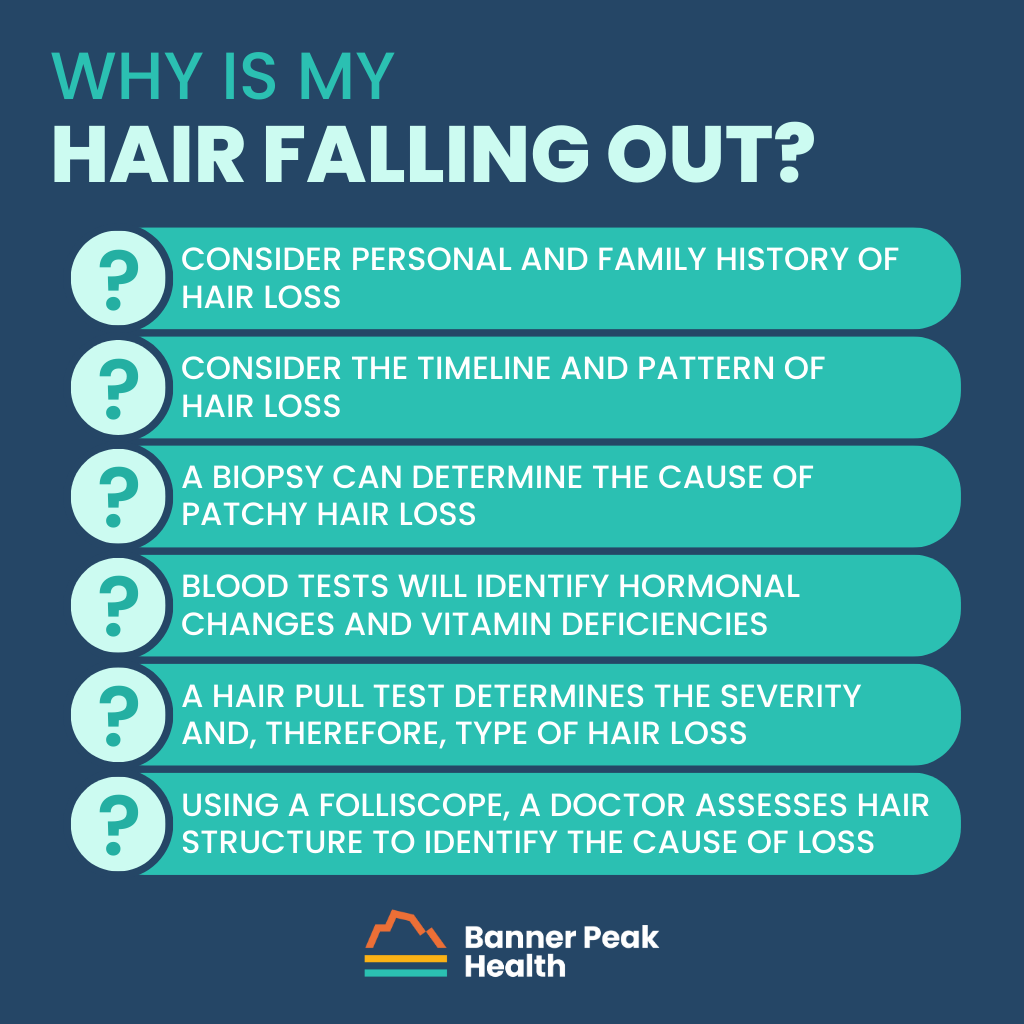One in three women asks her doctor about hair loss at some point.
Although hair loss is often considered more acceptable in men, women are almost as susceptible and often more emotionally impacted. They ask, “Why is my hair falling out so much?” “Will I need a wig?” “Am I going bald?”
The physical causes of hair loss range, and while hair loss can indicate a serious condition, it often doesn’t. Still, it’s essential that your doctor address all your questions and concerns.
I’ll try to answer the most common questions about hair loss in this blog post.

Types of Hair Loss
We generally divide hair loss into two categories: patchy and diffuse.
Patchy Hair Loss
Patchy hair loss occurs only in specific areas. It has two causes:
- Scarring: A rash (usually caused by a fungal infection), psoriasis, or discoid lupus leaves scarring, which inhibits hair growth.
- Non-Scarring: Also called alopecia areata, this kind of patchy hair loss is believed to be autoimmune and is fairly simple to diagnose.
Diffuse Hair Loss
Diffuse hair loss occurs over the entire scalp but begins on the crown and front. People refer to this as “thinning hair” or to their scalp getting “wider.” Causes of diffuse hair loss include:
- Androgenic Alopecia: This is classic “male-pattern baldness,” though it can also occur in women and commonly does (especially in women with a family history).
- Telogen Effluvium: This is the most common form of hair loss in women. All hair follicles synchronize, and most or all hair falls out simultaneously. Hormonal changes from pregnancy, thyroid disease, iron deficiency, and other physical or psychological stressors trigger telogen effluvium.
- Anagen Effluvium: Unlike telogen effluvium, anagen effluvium isn’t natural. Chemical damage like chemotherapy or exposure to heavy metals (mercury, arsenic, etc.) causes this condition.
- Topical Chemical, Heat, or Traction-Related Damage: Tying long hair back into braids or ponytails that are too tight, excessive heat from hairdryers and flat irons, and chemical damage from dyes cause this type of hair loss.
Identifying the Cause
The first step in treating hair loss is to determine the cause. When a patient asks, Why is my hair falling out so much?, I first consider their personal history, their family history, and the timeline and pattern of their hair loss.
Beyond that, the following tests can help in certain situations:
- A biopsy can determine the cause of patchy hair loss.
- Blood tests will identify hormonal changes (e.g., thyroid disease) and vitamin or mineral deficiencies (e.g., iron).
- A hair pull test determines the severity and, therefore, the type of hair loss.
- Using a folliscope, a doctor examines a hair’s structure to help determine the cause of the loss.

Traditional Treatments
Once the cause of your hair loss is determined, your doctor can begin treatment. The following treatments have been used for several years to treat hair loss in both men and women:
Iron Supplementation
If the cause of your hair loss is iron deficiency, we treat it with iron supplementation.
Thyroid Hormone Replacement
We treat thyroid disease with thyroid hormone replacement, which enables hair to regrow.
Hair Transplants
Hair transplants have been used to offset hair loss for many years but are costly, painful, and questionable in efficacy.
Treatments Exclusive to Androgenic Alopecia
Many women have polycystic ovarian syndrome (PCOS), which causes excessive testosterone that metabolizes into dihydrotestosterone (DHT). DHT harms hair follicles and leads to hair loss. Androgen blockers for PCOS help reduce DHT-related damage to hair follicles.
Oral spironolactone has effectively treated both men and women, especially when combined with minoxidil.
Women who won’t become pregnant and men may use the following treatments to treat androgenic alopecia:
- A low dose of oral finasteride can effectively prevent hair from falling out but doesn’t regrow hair.
- Minoxidil, the primary ingredient in Rogaine, has been used as a hair loss treatment for decades but is perhaps only 40% effective. It’s also inconvenient; most patients stop using it before seeing results.
New Treatment Options
Oral Minoxidil
Oral minoxidil, not to be confused with topical minoxidil, is an old blood pressure medication. It’s now used orally in low doses to prevent androgenic alopecia in males and females. Its efficacy in regrowing hair is impressive.
PRP (Platelet-Rich Plasma) Injections in the Scalp
PRP injections have shown promise as a treatment for hair loss, but their use is currently off-label. They’re also painful and short-acting.
Today’s Takeaways
- If you’re losing hair, pay attention to it. Know your history.
- Most of the time, we can diagnose hair loss by knowing its timeline and pattern and by doing bloodwork.
- Most of the time, especially for women, it’s telogen effluvium.
- Talk to your doctor. Don’t be afraid to ask, “Why is my hair falling out so much?”

Waheeda Hiller, MD
For over 20 years in Internal Medicine, Dr. Hiller has dedicated herself to providing unparalleled care to patients. She joined Banner Peak Health in 2023 as a concierge physician to better serve patients with the depth of thought, knowledge, and compassionate care they need to live the healthiest lives possible.



